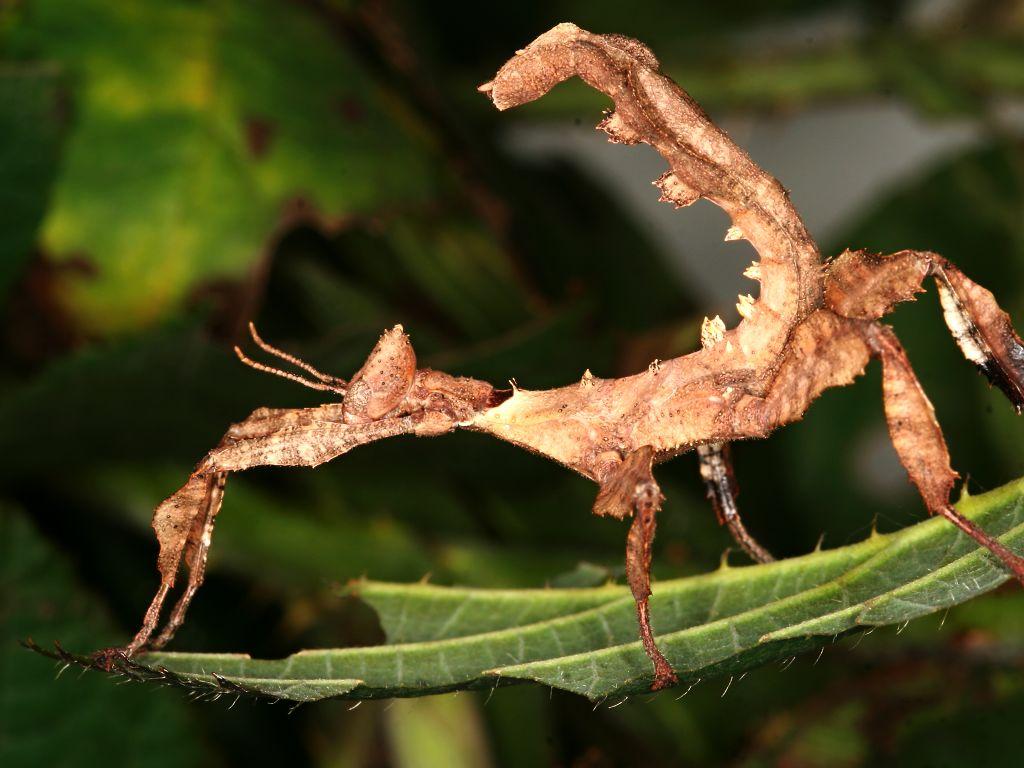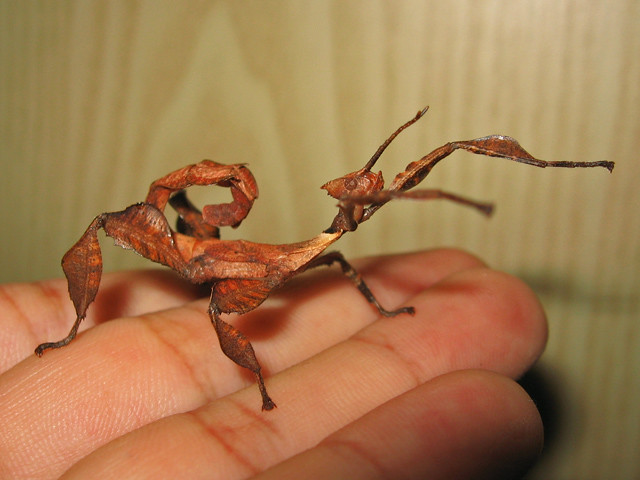Extatosoma tiaratum
Australian Stick Insect ( Extatosoma tiaratum ) ♂
The Australian Stick Insect ( Extatosoma tiaratum ) is a native to the tropics and subtropics of Australia Art of the order of the stick insects ( Phasmatodea ).
Features
The Australian Stick Insect is characterized by a long, thin body. At the leaf like looking limbs she has small spines. The body resembles parts of plants, especially leaves. This makes it very difficult for predators to discover ( mimesis ). It reaches a height of about 140 mm. In animals, this coloring can be yellow to brownish or green. The color varies due to various environmental conditions, such as food, and temperature. Also, Australian stick insects can recolor the course of their lives.
The males have fully trained wings with which to fly, the females only stub wings. Adult females are considerably thicker than the males. In contrast to the males, the females have on the back paired spines. Females carry the abdomen bent as imago scorpion -like over the head. In males, this is prevented after the last moult through the long wings.
The Australian stick insects have the ability to throw off limbs to designated break points between the leg and thigh ring ( autotomy ), and this partially replace at the next Larvalhäutung again (regeneration).
Australian stick insects can reproduce virgin ( parthenogenesis ). They let their eggs singly fall to the ground. The development time of the embryos is approximately 5 to 6 months and the nymphs about 4 to 6 months. During development, the animals molt five ( males ) or six times (females ). The newly hatched juveniles have a small black petite body and a red head. With their appearance and their movements they imitate the Australian ant genus Leptomyrmex.
Adult females live for up to a year, males reach an age 3-5 months.
Behavior
The Australian stick insects walk for locomotion around only slowly. Mostly they move away in the night and during the day remain in the same place. In addition, they rock when moving back and forth, thereby mimic moved by the wind plant parts. The same swing effect occurs when moving in the vicinity of the stick insects parts of plants or animals. In addition to the appearance of the ghost insects camouflage also accumulate from their predators. Adult males are also able to fly.
Australian stick insects are leaf-eating animals and feed in their homeland of eucalyptus. However, they also eat blackberry, raspberry, black currant, rose, oak, beech, hawthorn, or hawthorn leaves. The most popular, however, are in the terrarium blackberry leaves, as these are eaten and are evergreen.
Eggs are hurled by the females from the abdomen and land on the ground. Australian fire ants of the genus Leptomyrmex collect these eggs that look like plant seeds, and transport them to their storage chambers in the ants' nest. The shell can not be broken for the ants, because it is too thick. Due to the climate in these buildings, the nymphs can develop and hatch from there. In the first two to three days they visually see the fire ants are very similar. That is, her body is black and the red head. This enables them to escape unharmed from the buildings. The young animals running around a few days at a fast pace, before they come to a suitable food plant to rest.
System
The species has been described several times, which has led to various synonyms. At times it has been divided into two subtypes, each subtype was assigned a synonym:
- Extatosoma tiaratum bufonium Westwood, 1874 (Syn. = Extatosoma elongatum Froggatt, 1922)
- Extatosoma tiaratum tiaratum ( MacLeay, 1827) (Syn. = Extatosoma hopii Gray, G. R., 1833)
Meanwhile, all local forms should only be regarded as variants of Extatosoma tiaratum and thus all other names have become synonymous.
The Australian Stick Insect is run by the Phasmid Study Group under the PSG number 9.






